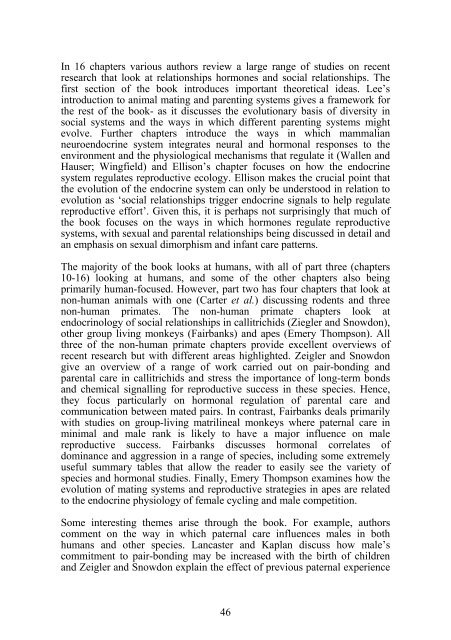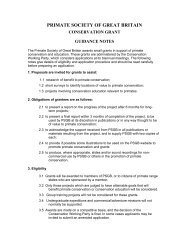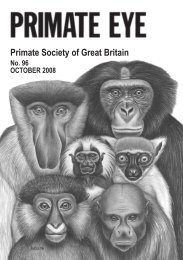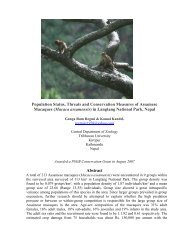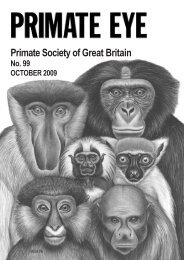2010 Vol 101.pdf (1.63mb) - Primate Society of Great Britain
2010 Vol 101.pdf (1.63mb) - Primate Society of Great Britain
2010 Vol 101.pdf (1.63mb) - Primate Society of Great Britain
Create successful ePaper yourself
Turn your PDF publications into a flip-book with our unique Google optimized e-Paper software.
In 16 chapters various authors review a large range <strong>of</strong> studies on recent<br />
research that look at relationships hormones and social relationships. The<br />
first section <strong>of</strong> the book introduces important theoretical ideas. Lee’s<br />
introduction to animal mating and parenting systems gives a framework for<br />
the rest <strong>of</strong> the book- as it discusses the evolutionary basis <strong>of</strong> diversity in<br />
social systems and the ways in which different parenting systems might<br />
evolve. Further chapters introduce the ways in which mammalian<br />
neuroendocrine system integrates neural and hormonal responses to the<br />
environment and the physiological mechanisms that regulate it (Wallen and<br />
Hauser; Wingfield) and Ellison’s chapter focuses on how the endocrine<br />
system regulates reproductive ecology. Ellison makes the crucial point that<br />
the evolution <strong>of</strong> the endocrine system can only be understood in relation to<br />
evolution as ‘social relationships trigger endocrine signals to help regulate<br />
reproductive effort’. Given this, it is perhaps not surprisingly that much <strong>of</strong><br />
the book focuses on the ways in which hormones regulate reproductive<br />
systems, with sexual and parental relationships being discussed in detail and<br />
an emphasis on sexual dimorphism and infant care patterns.<br />
The majority <strong>of</strong> the book looks at humans, with all <strong>of</strong> part three (chapters<br />
10-16) looking at humans, and some <strong>of</strong> the other chapters also being<br />
primarily human-focused. However, part two has four chapters that look at<br />
non-human animals with one (Carter et al.) discussing rodents and three<br />
non-human primates. The non-human primate chapters look at<br />
endocrinology <strong>of</strong> social relationships in callitrichids (Ziegler and Snowdon),<br />
other group living monkeys (Fairbanks) and apes (Emery Thompson). All<br />
three <strong>of</strong> the non-human primate chapters provide excellent overviews <strong>of</strong><br />
recent research but with different areas highlighted. Zeigler and Snowdon<br />
give an overview <strong>of</strong> a range <strong>of</strong> work carried out on pair-bonding and<br />
parental care in callitrichids and stress the importance <strong>of</strong> long-term bonds<br />
and chemical signalling for reproductive success in these species. Hence,<br />
they focus particularly on hormonal regulation <strong>of</strong> parental care and<br />
communication between mated pairs. In contrast, Fairbanks deals primarily<br />
with studies on group-living matrilineal monkeys where paternal care in<br />
minimal and male rank is likely to have a major influence on male<br />
reproductive success. Fairbanks discusses hormonal correlates <strong>of</strong><br />
dominance and aggression in a range <strong>of</strong> species, including some extremely<br />
useful summary tables that allow the reader to easily see the variety <strong>of</strong><br />
species and hormonal studies. Finally, Emery Thompson examines how the<br />
evolution <strong>of</strong> mating systems and reproductive strategies in apes are related<br />
to the endocrine physiology <strong>of</strong> female cycling and male competition.<br />
Some interesting themes arise through the book. For example, authors<br />
comment on the way in which paternal care influences males in both<br />
humans and other species. Lancaster and Kaplan discuss how male’s<br />
commitment to pair-bonding may be increased with the birth <strong>of</strong> children<br />
and Zeigler and Snowdon explain the effect <strong>of</strong> previous paternal experience<br />
46


